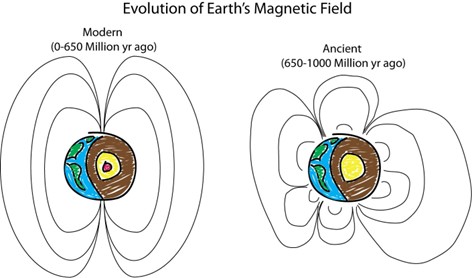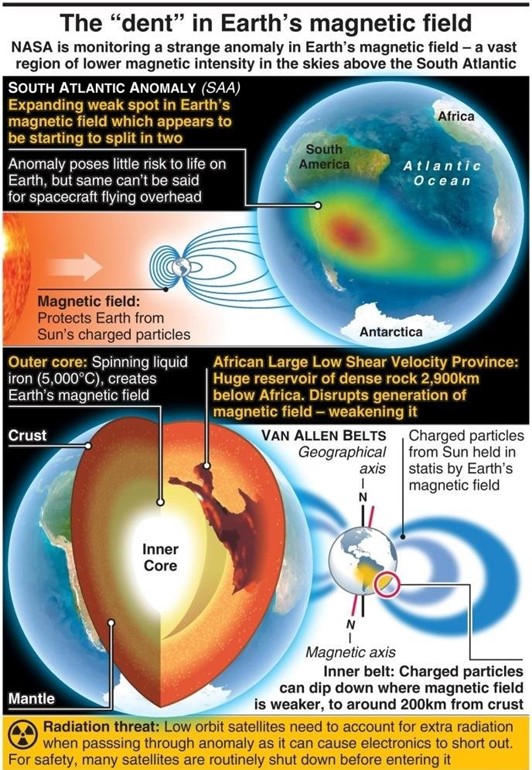Important Facts For Prelims
Earth's Ancient Magnetic Field
- 30 Apr 2024
- 6 min read
Why in News?
Recently, a study in the Journal of Geophysical Research by geologists at the Massachusetts Institute of Technology and Oxford University unveiled insights into Earth's ancient magnetic field, as revealed by ancient rocks, shedding light on its early geological evolution.
What are the Key Findings of the Study?
- Strength of Magnetic Field:
- Geologists discovered ancient rocks in the Isua Supracrustal Belt in southwestern Greenland dating back approximately 3.7 billion years, bearing the oldest remnants of Earth’s early magnetic field.
- The rocks retain signatures of a magnetic field with a strength of at least 15 microtesla, similar in magnitude to Earth’s magnetic field today (around 30 microtesla).
- Geologists discovered ancient rocks in the Isua Supracrustal Belt in southwestern Greenland dating back approximately 3.7 billion years, bearing the oldest remnants of Earth’s early magnetic field.
- Magnetic Field's Lifetime:
- Previous studies suggested a magnetic field on Earth at least 3.5 billion years old, but this study extends its lifetime by another 200 million years.
- Using uranium-to-lead ratio analysis, researchers estimated that some of the magnetised minerals in the rocks were approximately 3.7 billion years old.
- Potential Role in Earth's Habitability:
- The early magnetic field may have played a critical role in making the planet habitable.
- It likely helped retain a life-sustaining atmosphere and shielded the planet from damaging solar radiation.
- The early magnetic field may have played a critical role in making the planet habitable.
Uranium-to-Lead Ratio Analysis
- Uranium-lead dating, or U-Pb dating, is a radiometric dating technique that uses the ratio of uranium isotopes to lead isotopes to determine the age of earth materials.
- The ratio of uranium to lead is used to determine the rate at which uranium decays into lead, which is then used to determine the age of a rock.
What is Earth's Magnetic Field?
- About:
- Earth's magnetic field, also known as the geomagnetic field, is generated in the planet's interior and extends into space, creating a region called the magnetosphere and interacting with the solar wind.
- The magnetic field is generated by convection currents of molten iron and nickel in the Earth's core, which carry charged particles and generate magnetic fields.
- Not only Earth, but Jupiter, Saturn, Uranus, and Neptune also have strong magnetic fields, which are not fully understood.
- Mars lacks the inner heat and liquid interior needed for a magnetic field, while Venus has a liquid core but spins too slowly to generate one.
- Geodynamo Process:
- Earth's magnetic field is generated by the geodynamo process in the outer core.
- The convective energy from the slow-moving molten iron in the outer core is converted to electrical and magnetic energy, inducing a positive feedback loop.
- Earth's magnetic field is generated by the geodynamo process in the outer core.
- Magnetic poles:
- Earth has two sets of poles: the geographic poles and the magnetic poles.
- The geographic North and South poles are the locations where the lines of longitude converge, with the Geographic North Pole situated in the middle of the Arctic Ocean and the Geographic South Pole located in Antarctica.
- In contrast, the magnetic poles are the locations where the magnetic field lines enter and exit the Earth's surface.
- The Magnetic North Pole, also known as the North Dip Pole, is currently found on Ellesmere Island in northern Canada.
- When a compass points north, it is aligning itself with the Earth's magnetic field and pointing towards the Magnetic North Pole, not the true Geographic North Pole.
- Earth has two sets of poles: the geographic poles and the magnetic poles.
- Protection from Space Weather:
- Earth's magnetosphere shields the planet from harmful space weather, such as solar wind, coronal mass ejections (CMEs), and cosmic rays.
- The magnetosphere repels harmful energy away from Earth and traps it in zones called the Van Allen radiation belts.
- Geomagnetic Storms and Auroras:
- During strong space weather events, Earth's magnetic field can be disturbed, leading to geomagnetic storms that can cause power blackouts and communication disruptions.
- Disturbances in Earth's magnetic field also funnel ions towards the polar regions, creating spectacular auroras (northern lights and southern lights).
UPSC Civil Services Examination, Previous Year Questions (PYQs)
Prelims
Q. If a major solar storm (solar flare) reaches the Earth, which of the following are the possible effects on the Earth?
- GPS and navigation systems could fail.
- Tsunamis could occur at equatorial regions.
- Power grids could be damaged.
- Intense auroras could occur over much of the Earth.
- Forest fires could take place over much of the planet.
- Orbits of the satellites could be disturbed.
- Shortwave radio communication of the aircraft flying over polar regions could be interrupted.
Select the correct answer using the code given below:
(a) 1, 2, 4 and 5 only
(b) 2, 3, 5, 6 and 7 only
(c) 1, 3, 4, 6 and 7 only
(d) 1, 2, 3, 4, 5, 6 and 7
Ans: (c)






